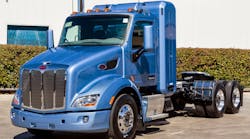FT. WORTH, Texas. Since 2006, the cost to fuel an on-highway tractor, assuming no change to mpg, has increased $25,000 per year due to the increased price of diesel alone. That is the hard fact that Robert Woodall, director of sales & marketing for Peterbilt Motors Co. told the assembled audience of Peterbilt customers here on Wednesday as part of the Commitment to Class Customer Event.
And that is why alternative fuels, particularly natural gas, are gaining market share so quickly.
“Diesel engines have served us well for decades, and will for decades to come, but today we have alternatives,” said Charles Cook, market segment manager-vocational products, noting that North America is trailing countries such as Iran and Pakistan in the percentage of natural-gas vehicles on the roads today.
Cook, who said that Peterbilt’s first factory installed natural gas engine came in 1997, now has six natural gas models available with two engine choices (9L and 12L) and the choice of either liquefied or compressed natural gas. He added that Peterbilt held 40% of the natural gas truck market in 2013, selling some 1,500 vehicles. That should increase to around 2,000 this year.
Cook was just one of the speakers during the event to talk about natural gas. Peterbilt brought in experts from Clean Energy Fuels, Quantum Fuel Systems, Chart Industries, Cummins and even two fleets to discuss the advantages – and even the disadvantages – of the alternative fuel.
Wally Dubno, sales manager for the facilities modifications group of Clean Energy, ran through some of the basic codes involved in building natural gas facilities and provided a brief outline of how Clean Energy can help in building that infrastructure. Dubno said that Clean Energy now has 650 fleet customers and will have 500 fueling stations operational by the end of the year.
Peter Murray, general manager of the vehicle fueling business for Chart LNG, and David Mazaika of Quantum Fuel Systems, which produces tank systems, gave an overview of their respective products.
Mazaika noted that tanks are designed to last a long time and be durable. Quantum’s tanks are designed to withstand pressures up to 10,000 psi. “There isn’t a station today that can do that,” he said, adding that the tanks are expected to last 20 years.
Quantum is also releasing a new BOC 123 system. This back-of-cab system is designed to hold enough natural gas to enable a 500 mi. driving range at 5 mpg. Optional 2-frame rail tank modules can be added to extend the range to 860 mi., he said.
Kevin Ferguson, from Love’s Travel Stops, was honest in his company’s assessment with natural gas trucks to date. Love’s private fleet, Gemini Motor Transport, tested a Cummins Westport 9L natural gas engine in 2012 and the 12L models last year in beta mode.
“The 9L did okay, but we probably wanted a little more power,” he said. “[With the 12L], there are some inefficiencies in running the trucks. There is some fuel economy loss. We expected about a 12% loss, but we experienced about 18%, but that was a beta truck. We’re expecting better performance with the 25 production trucks we’ve [recently] been delivered.”
In fact, while the fleet expected a return-on-investment in about 2 years, that has changed. With slip-seating of drivers, the trucks are driving more miles than anticipated, Ferguson said, and the expected ROI is now about 1 year.
Of course, the powerplants for all these Peterbilt natural gas trucks come from Cummins Westport. Hugh Donnell, from Cummins, spoke about that company’s natural gas business, including the “product pause” in developing the ISX15 G 15L NG engine.
“We’re still evaluating where the market is going,” he said. “We think the 12L will be [suitable for many applications].”
Cummins Westport offers the ISB6.7 G, the ISL G 9Land the ISX12 G NG engines. One theme in Donnell’s speech, though, was that we don’t really know the final market share of natural gas. “There is no one that can tell you the rhythm of the market. This is not the normal.”
Donnell also downplayed the new potential “it” fuel, dimethyl ether (DME). “There’s not a big play for it, in my view, in this country with the abundance of petroleum and natural gas [resources],” he said.
To illustrate his point, Donnell mentioned that the U.S. currently has about 325 active natural gas wellheads, but that is just a fraction of the available capacity. He said there are another 1,200 or so wellheads that are capped currently but could quickly start producing gas – one reason he believes the price gap between natural gas and diesel will remain.
“No one expects natural gas [prices] to follow the [price volatility] of diesel,” he said. “I don’t see any volatility in the price of natural gas anytime soon, and by anytime soon, I mean within the next 100 years.”
Finally, Jeff Dillon, president and owner of Dillon Transport, which operates about 130 natural gas trucks in its fleets, issued a warning against shippers demanding rate reductions. Because natural gas can be up to $2 per gallon cheaper than diesel, some shippers may ask for rate relief. That happened to Dillon with Owens Corning.
But, the fleet was able to work out a “sliding fuel surcharge” where Owens received some relief in rates and Dillon was still able to recoup some of the savings on the cost of the fuel.
“You really need to keep some of that savings – don’t give it away,” Dillon said.



